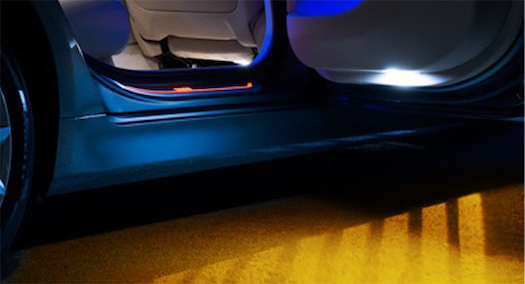



Feature Story
More feature stories by year:
2024
2023
2022
2021
2020
2019
2018
2017
2016
2015
2014
2013
2012
2011
2010
2009
2008
2007
2006
2005
2004
2003
2002
2001
2000
1999
1998
 Return to: 2017 Feature Stories
Return to: 2017 Feature Stories
CLIENT: SOCIETY FOR INFORMATION DISPLAY
Apr. 11, 2017: EBN
Seth Coe-Sullivan, Vice President & Chief Technical Officer
Advances in light-emitting diode (LED) technology continue to bring new opportunities in digital displays. Existing optical technologies are also benefiting from the LED boom, specifically holographic optical elements (HOEs). Holographic optical elements are holographic images embedded onto a thin, clear photopolymer film that can be applied to glass or plastic surfaces.
When a light source, such as a LED, is projected onto the surface, the invisible recorded holographic images come to life. Although the technology has existed for decades, scientists and engineers are turning once futuristic concepts into tangible opportunities for manufacturers and government agencies.
Because holographic images are captured on thin flexible films, engineers can create unique displays that would otherwise be impractical with conventional optics. For example, HOEs can redirect images from a light source that is hidden from view. HOEs can also create a transparent image on a surface such as glass or acrylic. While the possibilities are practically endless, the most practical applications of HOE technology being developed are head-up displays (HUDs) on helmets and smart glasses, as well as holographic light projection on car windshields and for interior and exterior lighting.
HOE presents multiple opportunities for the highly competitive, high-end automotive industry. Luminit scientists have been working on HOE technology for over a decade and have refined the holographic capabilities for brightness, transparency, and responsiveness to color selectivity (i.e., red, green, or blue). For example, HOE film combined with an LED light source would allow a floating, transparent image to appear on the windshield without any obstruction of view. Because color selectivity is now possible, RGB LEDs can be divided by color and placed on the same thin, clear HOE film. Red could display distance to the vehicle ahead, green an approaching car, and blue the current vehicle speed. The driver does not need to focus on the image to view it or ever take his or her eyes off the road.

Other uses for HOE in automobiles include hiding a light source, such as interior dome lights, or center high mount stop light (CHMSL) on the rear windshield of modern cars. Based on Luminit’s transparent holographic component technology, the film combines a holographic image area, an acrylic guide and an LED light source to transfer the projected light. An example of how this could applied to a car’s interior is the dome light. Dome lights typically protrude out of the vehicle ceiling. HOE film can be embedded in the liner and the light source can be concealed from view. Transparent in the off state, light from the dome would appear to come the liner. HOE can also be a key factor in branding. Floor lights or mud lights, for example, on high end cars can project light as well as the auto manufacturer’s logo.
HOE also performs well on heads up displays for pilots and motorcyclists as well as wearable technology such as smart glasses. For helmets, HOE possibilities include head-mounted displays for off-axis image projection of a high-resolution micro display through a thin plastic visor. For smart glasses, HOE eliminates prism-based optics currently used on Google glass with fully see-through technology that allows the images to be viewed at a virtual distance without added weight to the user.
Learn more about HOEs and other disruptive display technologies at next month’s Display Week 2017 in Los Angeles.
Dr. Fedor Dimov, Senior Technical Fellow, Luminit, co-authored this article.
Dr. Fedor Dimov is one of the world’s leading experts in thin film optics and holographic technologies. He implemented a variety of holographic materials (photo-thermoplastics, photo-thermorefractive glass, lithium niobate crystals and photopolymers) that resulted in a variety of prototypes for government and commercial projects. Dimov’s interests include data storage and search systems, water droplet measurement, opto-mechanical inertial sensors, laser beam detection, subwavelength resolution maskless technology based on surface plasmon resonance, holographic ultra-narrow passband filters and spectrometers, holographic solar concentrators, head-mounted displays and eye trackers. A leading member of Luminit’s substrate-guided holographic technology project that resulted in compact low-profile displays and sensors, Dimov holds multiple patents and received his Master degree in Physics from Moscow Institute of Physics and Technology and his Ph.D. in Applied Optics at Leningrad University of Fine Mechanics and Optics.
Return to: 2017 Feature Stories